ABS HONDA PILOT 2013 2.G Owners Manual
[x] Cancel search | Manufacturer: HONDA, Model Year: 2013, Model line: PILOT, Model: HONDA PILOT 2013 2.GPages: 488, PDF Size: 10.18 MB
Page 9 of 488
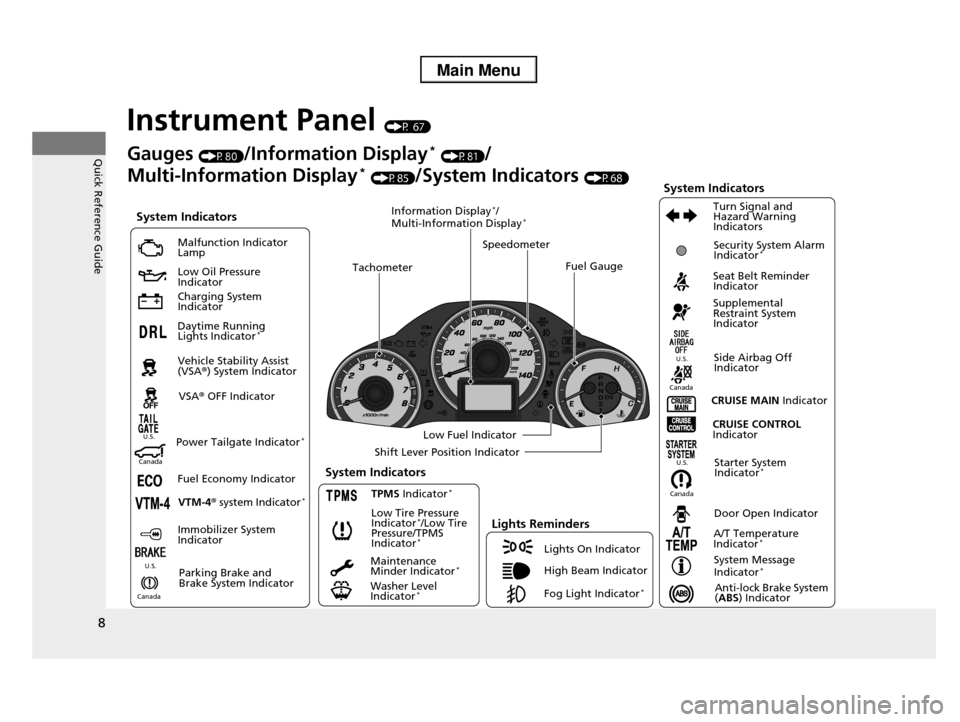
8
Quick Reference Guide
Instrument Panel (P 67)
System Indicators
Malfunction Indicator Lamp
Low Oil Pressure Indicator
Charging System Indicator
Daytime Running Lights Indicator*
Vehicle Stability Assist (VSA®) System Indicator
VSA® OFF Indicator
Low Tire Pressure Indicator*/Low Tire Pressure/TPMS Indicator*
Lights Reminders
Lights On Indicator
High Beam Indicator
Fog Light Indicator*
Immobilizer System Indicator
Seat Belt Reminder Indicator
System Indicators
CRUISE CONTROL Indicator
Parking Brake and Brake System Indicator
Supplemental Restraint System Indicator
Side Airbag Off Indicator
Door Open Indicator
CRUISE MAIN Indicator
Tachometer
Speedometer
Fuel Gauge
Low Fuel Indicator
Shift Lever Position Indicator
System Message Indicator*
Gauges (P80)/Information Display* (P81)/
Multi-Information Display* (P85)/System Indicators (P68)
Fuel Economy Indicator
VTM-4r system Indicator*TPMS Indicator*
Maintenance Minder Indicator*
Washer Level Indicator*
A/T Temperature Indicator*
Turn Signal and Hazard Warning Indicators
Starter System Indicator*System Indicators
Canada
U.S.
Canada
U.S.
Anti-lock Brake System (ABS) Indicator
Power Tailgate Indicator*
Security System Alarm Indicator*
Information Display*/Multi-Information Display*
Canada
U.S.
Canada
U.S.
Page 19 of 488
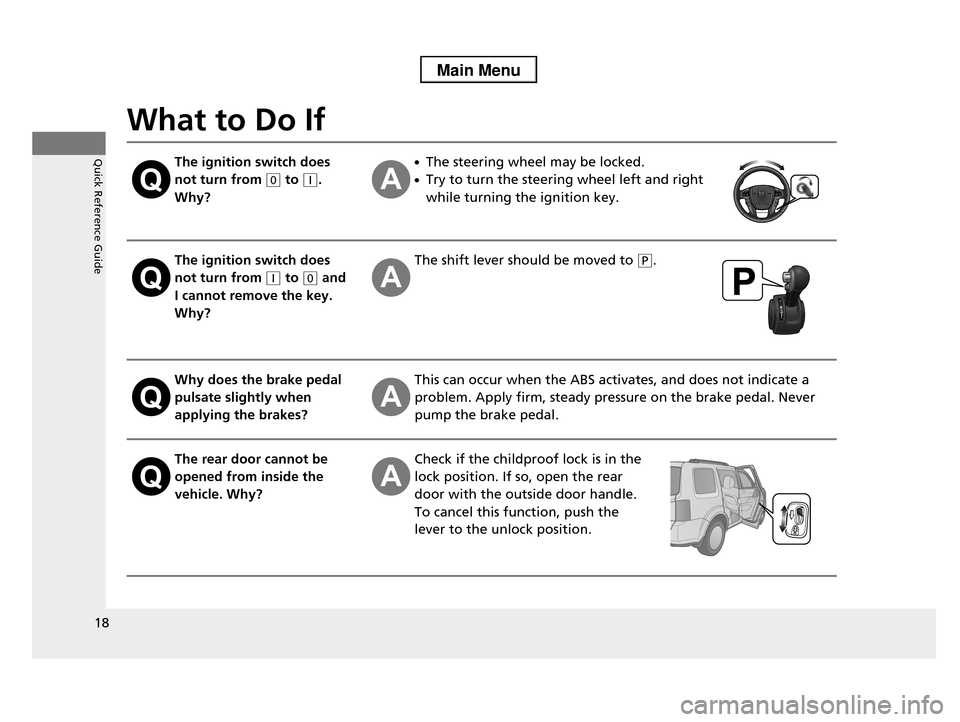
18
Quick Reference Guide
What to Do If
The ignition switch does
not turn from (0 to (q.
Why?
●The steering wheel may be locked.
●Try to turn the steering wheel left and right
while turning the ignition key.
The ignition switch does
not turn from (q to (0 and
I cannot remove the key.
Why?
The shift lever should be moved to (P.
Why does the brake pedal
pulsate slightly when
applying the brakes?
This can occur when the ABS activates, and does not indicate a
problem. Apply firm, steady pressure on the brake pedal. Never
pump the brake pedal.
The rear door cannot be
opened from inside the
vehicle. Why?
Check if the childproof lock is in the
lock position. If so, open the rear
door with the outside door handle.
To cancel this function, push the
lever to the unlock position.
Page 43 of 488
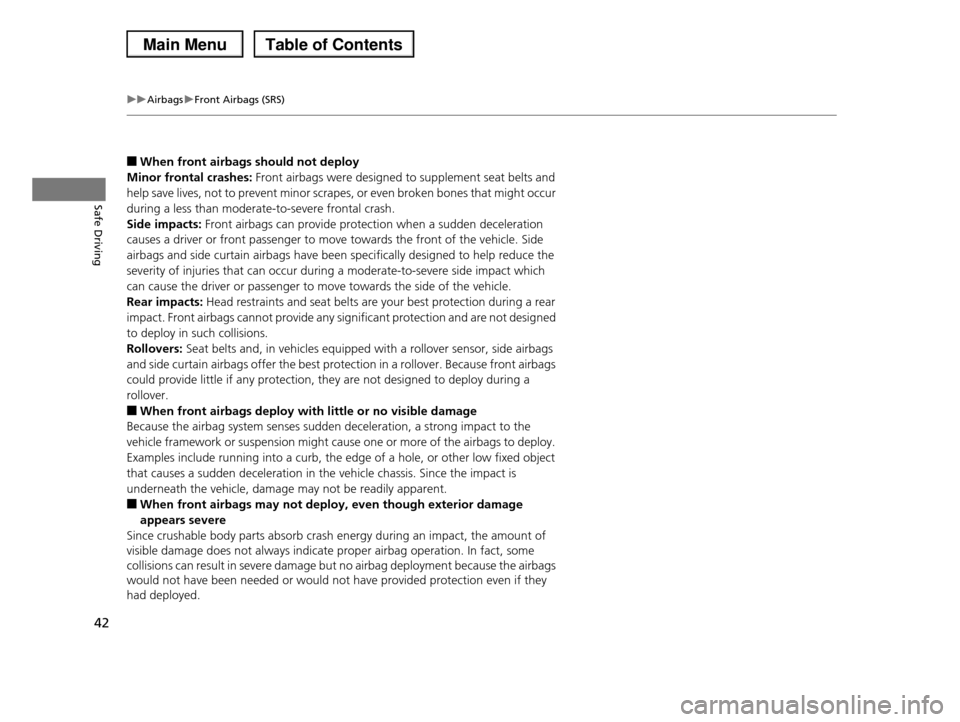
42
uuAirbagsuFront Airbags (SRS)
Safe Driving
■When front airbags should not deploy
Minor frontal crashes: Front airbags were designed to supplement seat belts and
help save lives, not to prevent minor scrapes, or even broken bones that might occur
during a less than moderate-to-severe frontal crash.
Side impacts: Front airbags can provide protection when a sudden deceleration
causes a driver or front passenger to move towards the front of the vehicle. Side
airbags and side curtain airbags have been specifically designed to help reduce the
severity of injuries that can occur during a moderate-to-severe side impact which
can cause the driver or passenger to move towards the side of the vehicle.
Rear impacts: Head restraints and seat belts are your best protection during a rear
impact. Front airbags cannot provide any significant protection and are not designed
to deploy in such collisions.
Rollovers: Seat belts and, in vehicles equipped with a rollover sensor, side airbags
and side curtain airbags offer the best protection in a rollover. Because front airbags
could provide little if any protection, they are not designed to deploy during a
rollover.
■When front airbags deploy with little or no visible damage
Because the airbag system senses sudden deceleration, a strong impact to the
vehicle framework or suspension might cause one or more of the airbags to deploy.
Examples include running into a curb, the edge of a hole, or other low fixed object
that causes a sudden deceleration in the vehicle chassis. Since the impact is
underneath the vehicle, damage may not be readily apparent.
■When front airbags may not deploy, even though exterior damage
appears severe
Since crushable body parts absorb crash energy during an impact, the amount of
visible damage does not always indicate proper airbag operation. In fact, some
collisions can result in severe damage but no airbag deployment because the airbags
would not have been needed or would not have provided protection even if they
had deployed.
Page 46 of 488
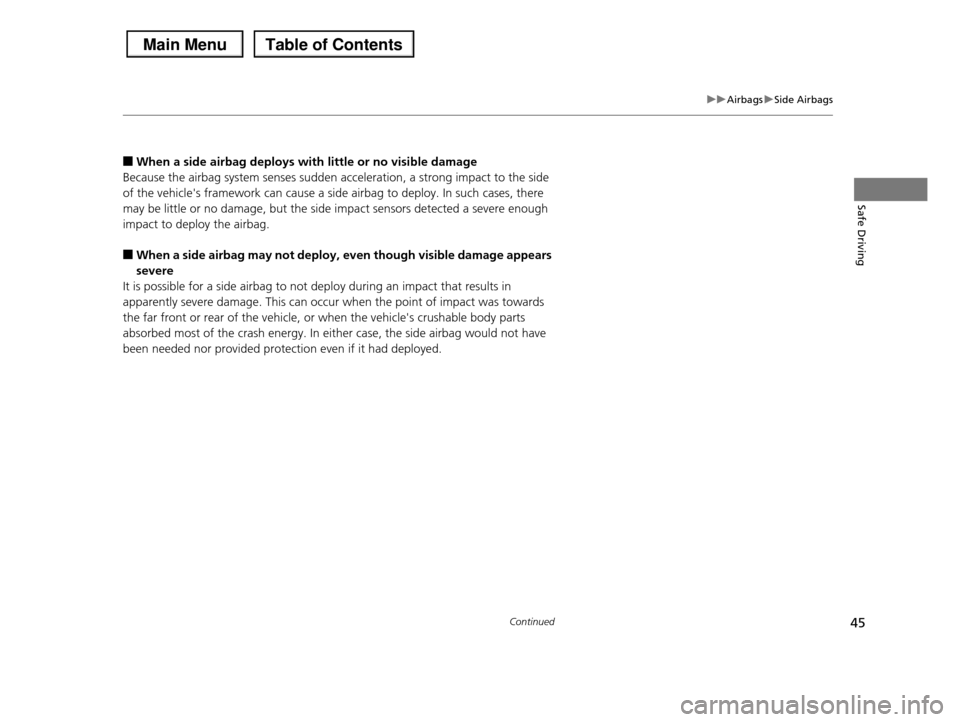
45
uuAirbagsuSide Airbags
Continued
Safe Driving
■When a side airbag deploys with little or no visible damage
Because the airbag system senses sudden acceleration, a strong impact to the side
of the vehicle's framework can cause a side airbag to deploy. In such cases, there
may be little or no damage, but the side impact sensors detected a severe enough
impact to deploy the airbag.
■When a side airbag may not deploy, even though visible damage appears
severe
It is possible for a side airbag to not deploy during an impact that results in
apparently severe damage. This can occur when the point of impact was towards
the far front or rear of the vehicle, or when the vehicle's crushable body parts
absorbed most of the crash energy. In either case, the side airbag would not have
been needed nor provided protection even if it had deployed.
Page 69 of 488
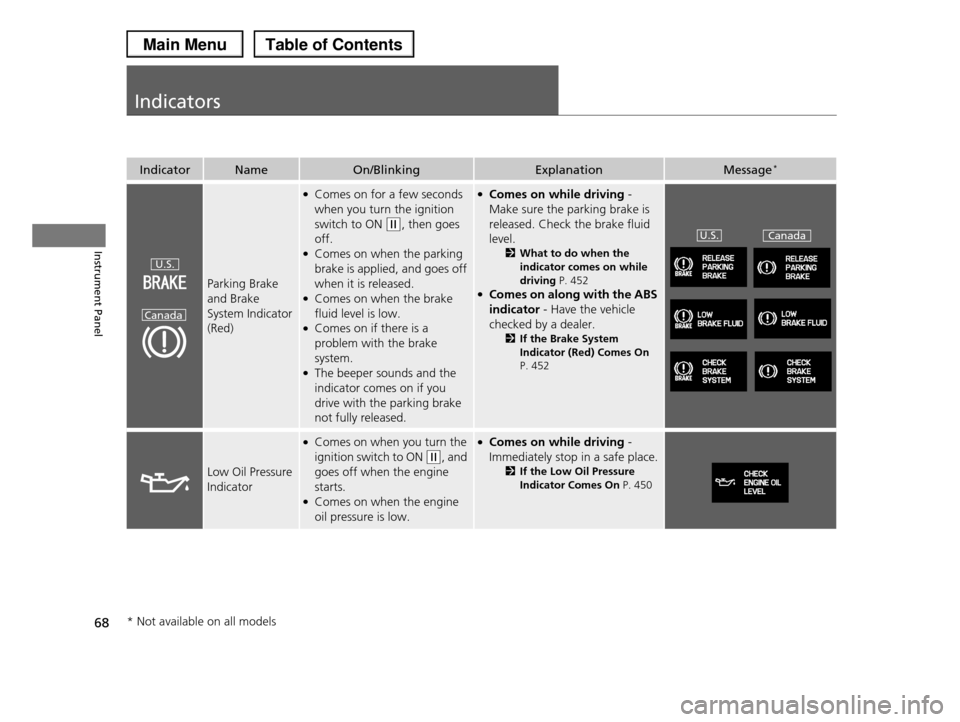
68
Instrument Panel
Indicators
IndicatorNameOn/BlinkingExplanationMessage*
Parking Brake
and Brake
System Indicator
(Red)
●Comes on for a few seconds
when you turn the ignition
switch to ON (w, then goes
off.●Comes on when the parking
brake is applied, and goes off
when it is released.●Comes on when the brake
fluid level is low.●Comes on if there is a
problem with the brake
system.●The beeper sounds and the
indicator comes on if you
drive with the parking brake
not fully released.
●Comes on while driving -
Make sure the parking brake is
released. Check the brake fluid
level.
2What to do when the
indicator comes on while
driving P. 452●Comes on along with the ABS
indicator - Have the vehicle
checked by a dealer.
2If the Brake System
Indicator (Red) Comes On
P. 452
Low Oil Pressure
Indicator
●Comes on when you turn the
ignition switch to ON (w, and
goes off when the engine
starts.●Comes on when the engine
oil pressure is low.
●Comes on while driving -
Immediately stop in a safe place.
2If the Low Oil Pressure Indicator Comes On P. 450
U.S.
Canada
U.S.Canada
* Not available on all models
Page 72 of 488
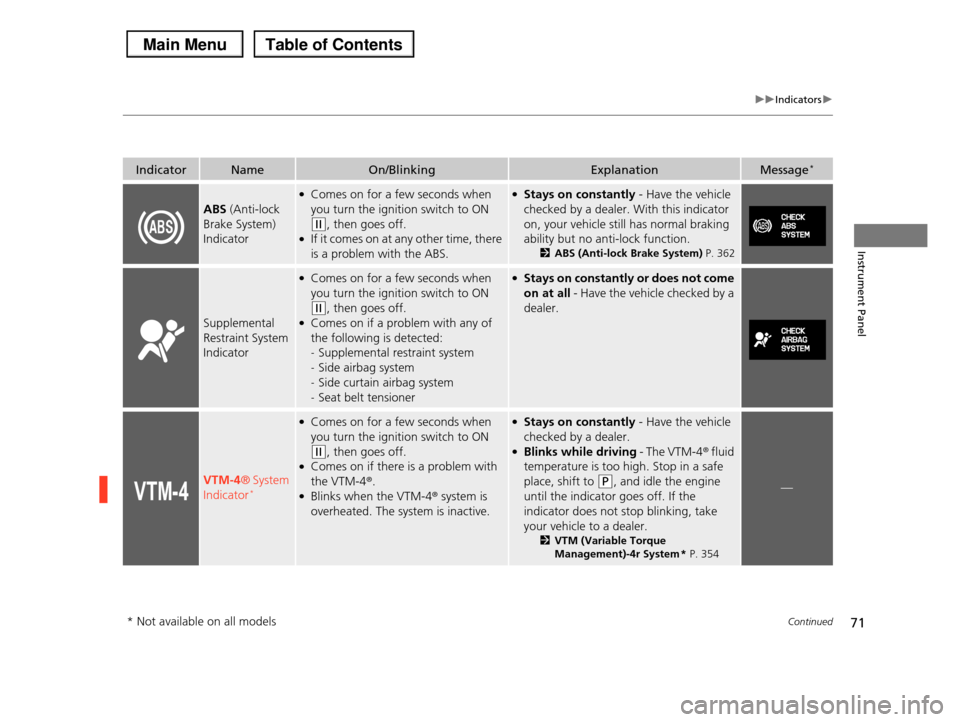
71
uuIndicatorsu
Continued
Instrument Panel
IndicatorNameOn/BlinkingExplanationMessage*
ABS (Anti-lock
Brake System)
Indicator
●Comes on for a few seconds when
you turn the ignition switch to ON
(w, then goes off.●If it comes on at any other time, there
is a problem with the ABS.
●Stays on constantly - Have the vehicle
checked by a dealer. With this indicator
on, your vehicle still has normal braking
ability but no anti-lock function.
2ABS (Anti-lock Brake System) P. 362
Supplemental
Restraint System
Indicator
●Comes on for a few seconds when
you turn the ignition switch to ON
(w, then goes off.●Comes on if a problem with any of
the following is detected:
-Supplemental restraint system
-Side airbag system
-Side curtain airbag system
-Seat belt tensioner
●Stays on constantly or does not come
on at all - Have the vehicle checked by a
dealer.
VTM-4® System
Indicator*
●Comes on for a few seconds when
you turn the ignition switch to ON
(w, then goes off.●Comes on if there is a problem with
the VTM-4®.●Blinks when the VTM-4® system is
overheated. The system is inactive.
●Stays on constantly - Have the vehicle
checked by a dealer.●Blinks while driving - The VTM-4® fluid
temperature is too high. Stop in a safe
place, shift to (P, and idle the engine
until the indicator goes off. If the
indicator does not stop blinking, take
your vehicle to a dealer.
2VTM (Variable Torque Management)-4r System * P. 354
—
* Not available on all models
Page 237 of 488
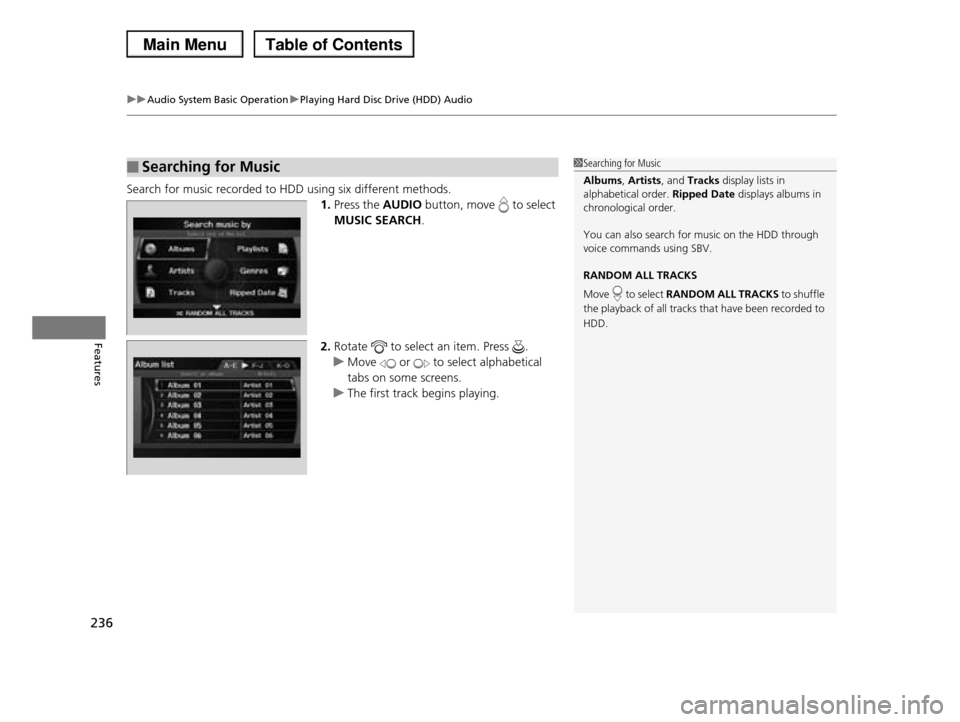
uuAudio System Basic OperationuPlaying Hard Disc Drive (HDD) Audio
236
Features
Search for music recorded to HDD using six different methods.
1.Press the AUDIO button, move to select
MUSIC SEARCH.
2.Rotate to select an item. Press .
uMove or to select alphabetical
tabs on some screens.
uThe first track begins playing.
■Searching for Music1Searching for Music
Albums, Artists, and Tracks display lists in
alphabetical order. Ripped Date displays albums in chronological order.
You can also search for music on the HDD through voice commands using SBV.
RANDOM ALL TRACKS
Move to select RANDOM ALL TRACKS to shuffle
the playback of all tracks that have been recorded to
HDD.
Page 318 of 488
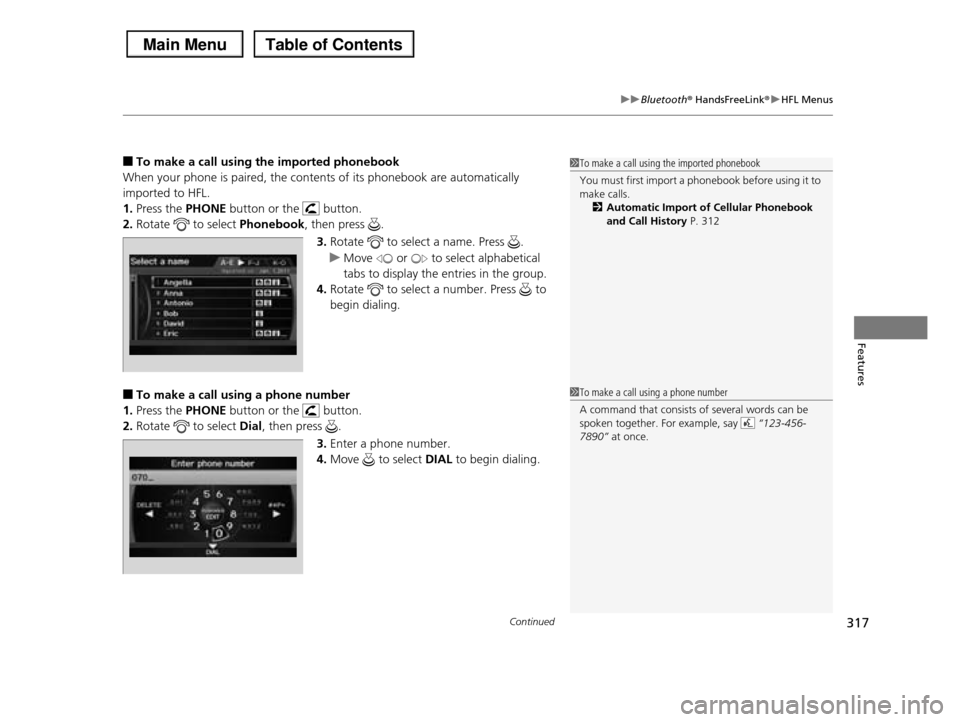
Continued317
uuBluetooth® HandsFreeLink®uHFL Menus
Features
■To make a call using the imported phonebook
When your phone is paired, the contents of its phonebook are automatically
imported to HFL.
1.Press the PHONE button or the button.
2.Rotate to select Phonebook, then press .
3.Rotate to select a name. Press .
uMove or to select alphabetical
tabs to display the entries in the group.
4.Rotate to select a number. Press to
begin dialing.
■To make a call using a phone number
1.Press the PHONE button or the button.
2.Rotate to select Dial, then press .
3.Enter a phone number.
4.Move to select DIAL to begin dialing.
1To make a call using the imported phonebook
You must first import a phonebook before using it to make calls.
2Automatic Import of Cellular Phonebook
and Call History P. 312
1To make a call using a phone number
A command that consists of several words can be spoken together. For example, say “123-456-
7890” at once.
Page 324 of 488
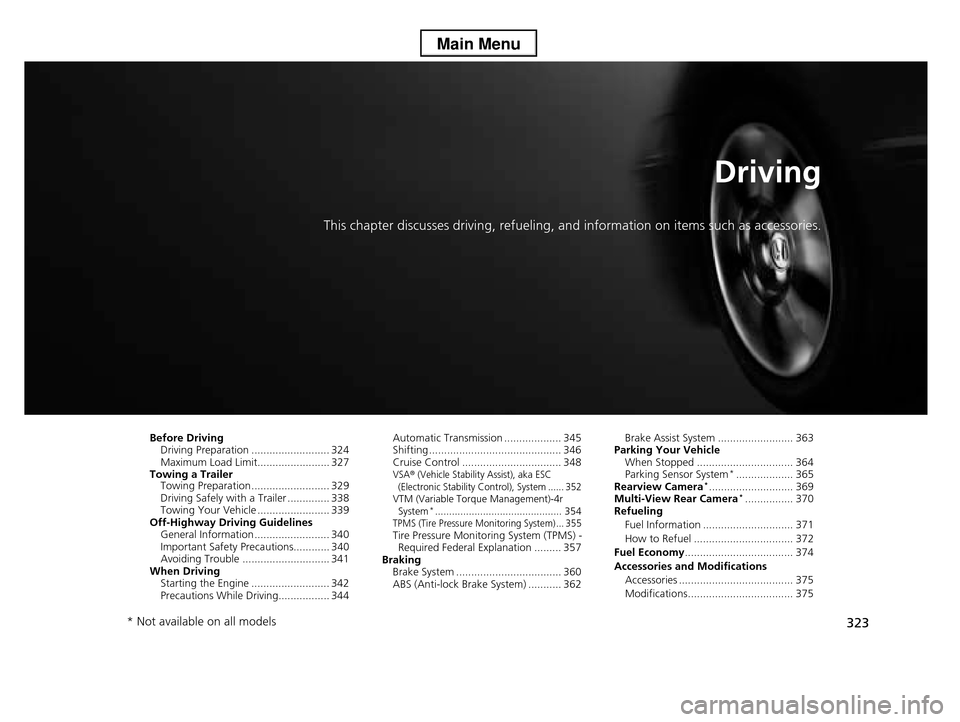
323
Driving
This chapter discusses driving, refueling, and information on items such as accessories.
Before DrivingDriving Preparation .......................... 324 Maximum Load Limit........................ 327Towing a TrailerTowing Preparation .......................... 329Driving Safely with a Trailer .............. 338Towing Your Vehicle ........................ 339Off-Highway Driving GuidelinesGeneral Information ......................... 340Important Safety Precautions............ 340Avoiding Trouble ............................. 341When DrivingStarting the Engine .......................... 342Precautions While Driving................. 344
Automatic Transmission ................... 345Shifting ............................................ 346Cruise Control ................................. 348VSA® (Vehicle Stability Assist), aka ESC (Electronic Stability Control), System ...... 352VTM (Variable Torque Management)-4r System*............................................. 354TPMS (Tire Pressure Monitoring System) ... 355Tire Pressure Monitoring System (TPMS) - Required Federal Explanation ......... 357BrakingBrake System ................................... 360ABS (Anti-lock Brake System) ........... 362
Brake Assist System ......................... 363Parking Your VehicleWhen Stopped ................................ 364Parking Sensor System*................... 365Rearview Camera*............................ 369Multi-View Rear Camera*................ 370Refueling
Fuel Information .............................. 371
How to Refuel ................................. 372
Fuel Economy.................................... 374
Accessories and Modifications
Accessories ...................................... 375
Modifications................................... 375
* Not available on all models
Page 362 of 488
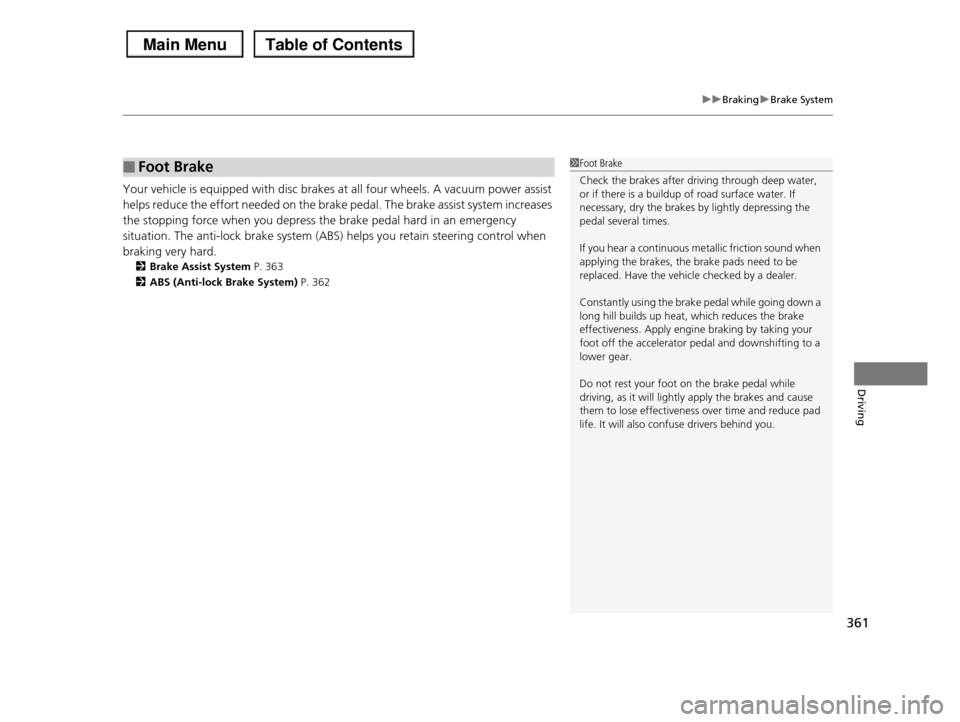
361
uuBrakinguBrake System
Driving
Your vehicle is equipped with disc brakes at all four wheels. A vacuum power assist
helps reduce the effort needed on the brake pedal. The brake assist system increases
the stopping force when you depress the brake pedal hard in an emergency
situation. The anti-lock brake system (ABS) helps you retain steering control when
braking very hard.
2Brake Assist System P. 363
2ABS (Anti-lock Brake System) P. 362
■Foot Brake1Foot Brake
Check the brakes after driving through deep water, or if there is a buildup of road surface water. If
necessary, dry the brakes by lightly depressing the
pedal several times.
If you hear a continuous metallic friction sound when
applying the brakes, the brake pads need to be replaced. Have the vehicle checked by a dealer.
Constantly using the brake pedal while going down a long hill builds up heat, which reduces the brake
effectiveness. Apply engine braking by taking your
foot off the accelerator pedal and downshifting to a lower gear.
Do not rest your foot on the brake pedal while driving, as it will lightly apply the brakes and cause
them to lose effectiveness over time and reduce pad
life. It will also confuse drivers behind you.